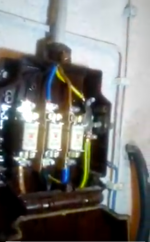Open Neutral
Senior Member
- Location
- Inside the Beltway
- Occupation
- Engineer
A friend in Wiesbaden related that he had an issue with an arcing panelboard ground. He'd also been having symptoms that screamed "open neutral" to me.
I freaked because it was a ground to the gas main feeding his house, and had been arcing under the clamp.
The POCO disclaimed responsibility and he paid a electrician to come out & investigate (EU 365 for afterhours callout). He arrived and in turn called the POCO who then did show up. They tightened the clamp but I remain concerned. The only reason I could see for such arcing was if that cable/clamp/pipe was actively carrying neutral current.
But I admit to knowing little of German wiring. I know they have 3-phase in far more residences than we do, and would assume that's 3hot+neutral.
Anyone familiar with their standards?
I freaked because it was a ground to the gas main feeding his house, and had been arcing under the clamp.
The POCO disclaimed responsibility and he paid a electrician to come out & investigate (EU 365 for afterhours callout). He arrived and in turn called the POCO who then did show up. They tightened the clamp but I remain concerned. The only reason I could see for such arcing was if that cable/clamp/pipe was actively carrying neutral current.
But I admit to knowing little of German wiring. I know they have 3-phase in far more residences than we do, and would assume that's 3hot+neutral.
Anyone familiar with their standards?

